I had one of those weekends spent at home organizing and cooking. They sometimes feel rare and far between but they sure make for a good week!
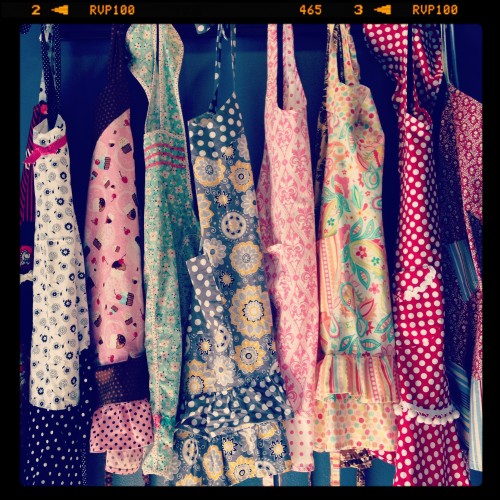

You know that pondering tilt of the head a person gives a work of art they’ve just completed? Writing about your life is that exactly. You step back, pick up your paint brush, apply a dab of compassion here, a brush stroke of flair over there. Putting your life on canvas allows you to see what your life looks like through the eyes of others.
Going Granny (actually my grandkids call me Nanny) is my best achievement yet! Here’s a phone message my barely two-year grandgirl left for me on my 58th b-day. I guarantee it; this will make your day.






























I had one of those weekends spent at home organizing and cooking. They sometimes feel rare and far between but they sure make for a good week!



When I say “yarn painting,” what do you envision?

Photo by Pixelverve.com via Wikimedia Commons
Yarn strands dipped in paint and swirled on canvas?
Nice idea, popular with the kiddos, but that’s not quite what I meant.
Painting skeins of yarn?
Gorgeous …

Photos courtesy of Poppy Gall Design Studio
But, I’m thinking along a different thread.
Yarn painting doesn’t actually have anything to do with paint, per say, but the end result could be confused with a painting,

Photo of traditional Huichol string art by Jebulon via Wikipedia
until you look at it up close …
These works of art look very tedious to do! I guess once you get the hang of it , the process flows better? The beautiful skeins of colored yarn hanging up in the sun make me want to knit!


Tree Dreams.
I love the idea of it. But what does it mean?

Photo by Steve Swayne via Wikimedia Commons
When I saw the site called Tree-Dreams.org, I had to know—what is it?
Well, it turns out to be a lovely project launched by author (and avid tree hugger) Kristin Kaye. Inspired by our silently branching neighbors, Kristin wants to encourage the scattering of “tree dreams” around the globe.
“I get this rush of wisdom,” she says of her time with trees, “and want to lie down like a lazy cat and hear their stories.”
When she isn’t listening, Kristin is beckoning others to share stories and ideas with the world by way of Tree Tags.
“A stealthy and merry band of Tree Taggers is already at work spreading the ideas that sustain us all, like love, kindness, generosity, giving, and interconnectedness … anyone can be a Tree Tagger.”
How?
This idea is so perfect for helping everyone deepen their awareness and appreciation of various species of trees. It would also be the perfect school project with children of all ages. Imagine a classroom getting a membership and then having fun planting 10 trees on the school campus to make it greener and more beautiful! I love this!


Usually, it’s an “X” that marks the spot …
So what would you think if you ran across one of these big ol’ arrows?
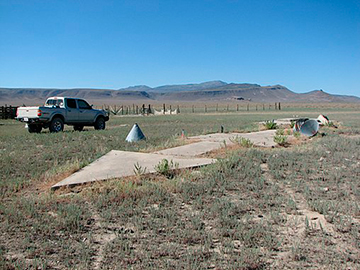
Courtesy of Craig; AAIR, Aviation Archaeological Investigation and Research;
http://www.aviationarchaeology.com
Perhaps a large-scale geocaching symbol?
Wacky art piece?
Landing beacon for aliens?
Or a treasure hunt for the giants of Jack and the Beanstalk …
Actually, the last one isn’t far off.
These arrows were, in fact, a treasure map of sorts.
Though ixnay on the giants-ay … think aeronautics instead.
The treasure?
U.S. mail.
Prior to 1924, mail could take upwards of a month to arrive at its destination. The Pony Express, which solely delivered mail, was disbanded in 1861 as the Transcontinental Railroad took up the yoke and continued to improve the speed of mail delivery.
The railroad was completed from sea to shining sea in 1869, and until 1903, was the main means of mail delivery. That is, until the Wright Brothers completed their first successful flight and initiated the age of air travel.
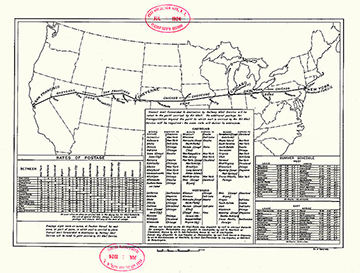
U.S. Post Office Department map of the First Transcontinental Air Mail Route involving both day and night flying over the entire route opened July 1, 1924. Courtesy of Wikimedia Commons; PD-USGOV.
The Transcontinental Air Mail Route was 2,629-miles long, stretching between San Francisco, California, to New York, New York.
Needing no roads, train tracks, or animals, the advancement of air travel had just one hurdle to overcome: night.
Without high-tech navigation systems, a pilot could only fly during the day.
The solution?
Like breadcrumbs for a pilot, a series of beacons was built and lit—one every 10 miles.
Here is one of those “breadcrumbs,” a 51-foot steel tower.
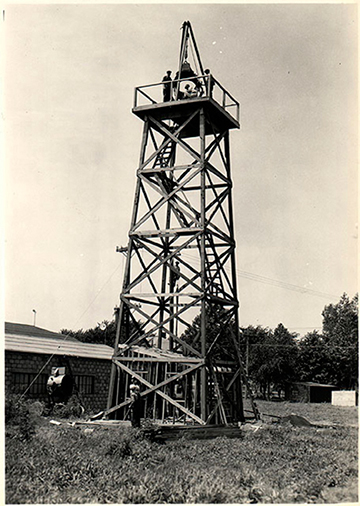
Revolving light beacon towner being built, Omaha, 1920s. Courtesy of Postal Museum.http://www.postalmuseum.si.edu/museum/1d_Airmail_Beacon.html
Below is a drawing of the structure. Each was lit by a million-candlepower rotating beacon. As long as pilots could see the concrete “yellow brick road,” they could fly by night.
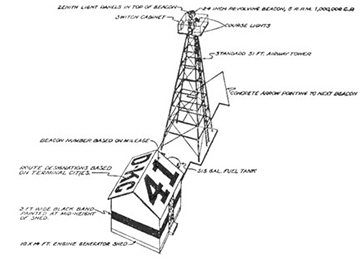
Airway beacon. Courtesy of Wikimedia Commons; U.S. DOT FAA
This allowed mail to cross the country in 30 hours or so, depending on conditions.
As fast as technology grows, the beacons were rendered obsolete by the ’40s. Most of the towers were torn down and the steel was used for the war effort, but hundreds of the yellow arrows remain.
The Western New Mexico Aviation Heritage Museum is in the process of restoring an airway beacon tower and its electric generator for visitors. More on that here.
What a unique piece of history. My son is a jet mechanic and I can’t wit to share this with him. (though he probably already knows all about this!)
Very interesting! I had no idea that anything like this existed in the first place, let alone, is still around. How cool! If I were to come upon one of these yellow arrows, I would never guess what it’s original purpose was. Thank you for sharing!
Cool. There are some beacon sites on the National Forest where I work, but no arrows. Tangles of steel cables on mountain tops are all that’s left. The ingenuity of people back in “low-tech” days never fails to amaze me, and I feel that something has been lost…


Ace brought in a little treat last week to the Design Studio. One of my favorites that I ate for breakfast a few months back—with glee! The Pastor’s Wife’s Pie, as we call it, is a custard with a graham-cracker crust using my ChillOver Powder.

Easy, delicious, and something other than a typical cake. (This Pistachio Melon Cake is also another great option—especially if you’re gluten-free.) Both are a great contribution to a potluck or for a special occasion. (Just keep the custard on ice, or refrigerated until serving.)
The one Ace made substituted blackberries for blueberries in the recipe. Thanks, Ace!
Feelin’ a little stressed lately? It’s Labor Day so I hope you’re taking some time to relax. A little on the history of Labor Day here.
Enjoy this mantra (and any other desserts you consume) for the rest of the week …

Good article to read to remind us of the laborers who keep this country going. And many thanks to the farmers!


What’s going on with this little guy’s muzzle, er, trunk?
Schnoz … sniffer … honker?
You may have recognized his protruding proboscis before you knew his name …
Or maybe his little springy piece of hair?
Meet Kilroy.
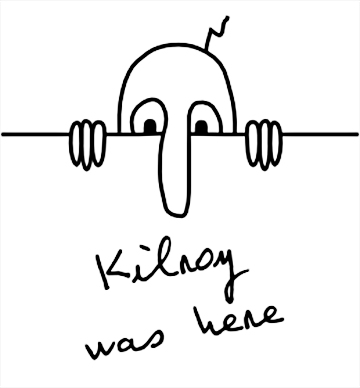
“Kilroy was here” graphic. Courtesy of Wikimedia Commons; KovacsUr
Anyone born between 1913 and 1955 (who didn’t live under a rock) would be aptly familiar with our long-nosed friend. (Though if you did live under a rock, you probably had to come out sometime, and Kilroy may have been there first.)
During church service as a young girl, my dad and I were known to draw a Kilroy or two to get through the length of service. But his origins remained a bit of a mystery until 1946.
The American Transit Association sponsored a contest that year, “The Real Kilroy,” which was announced on the radio program “Speak to America.”
The person who could prove they were the real Kilroy would win a real trolley car.
About 40 men laid claim to the infamous drawing, but only one stood atop the rest. That was James Kilroy from Halifax, Massachusetts.
Here’s how his story went:
Mr. Kilroy was a 46-year-old shipyard worker who counted rivets during the war. As he counted, he would place a check mark on each so as not to count twice. Riveters were paid for each completed rivet.
After he clocked off for the day, the riveters would wipe off the check marks. As the shipyard inspector went on duty, he would count the unchecked rivets a second time. This resulted in double pay for the riveters.
Kilroy’s boss, noticing the increase in the riveters’ wages, asked Kilroy to investigate. When the scandal was discovered, a solution was devised.
Trying to use a more permanent solution, such as paint, would have proven tricky, considering the tight spaces. So Kilroy stuck with his waxy chalk, but added “KILROY WAS HERE” next to each check mark. Then, he eventually added the sketch of the long-nosed fellow peering over the fence.
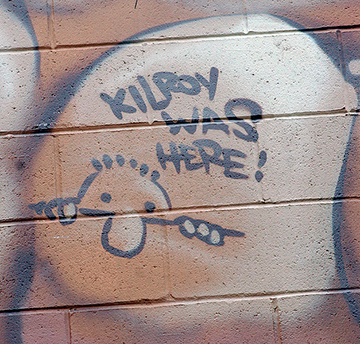
Kilroy was here, seen in Kansas City, MO. Courtesy of Wikimedia Commons; Marshall Astor
Once it was discovered they had been caught, the riveters quit wiping away his marks. Maybe the guilt of Kilroy “watching” stopped them in their tracks?
Normally, the chalk marks and rivets would have been covered up with paint. With the war on, however, there wasn’t any time to paint over them as they left the shipyard at an increasing speed.
Therefore, Kilroy’s inspection trademark was seen by thousands of servicemen.
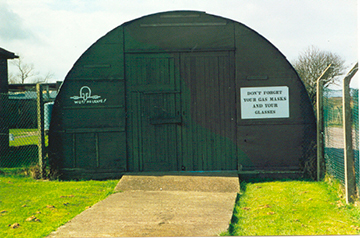
Kilroy. Courtesy of Wikimedia Commons; Ron Hann
Kilroy made a lasting impression with the troops and was mimicked everywhere—from Berlin to Tokyo. It became a challenge to see how far, high, or low Kilroy could go.
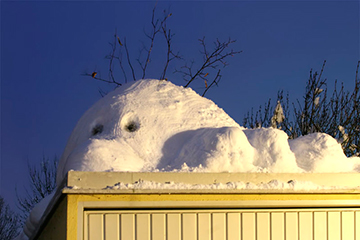
Photograph of a Kilroy was here-style snowman; Courtesy of Wikimedia Commons; Florian Kilzer
Kilroy is rumored to be atop Mount Everest, the Statue of Liberty, and on the underside of the Arc de Triomphe. Some say he is even scrawled in the dust on the moon.
The moon? Well, who knows, but he is on the back of the National World War II Memorial in Washington, D.C.—forever immortalized.
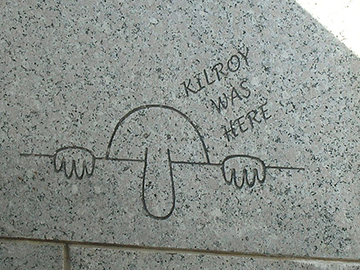
Kilroy was here engraving at the National World War II Memorial in Washington, D.C. Courtesy of Wikimedia Commons; Matt H. Wade
Wherever Kilroy is, and however he came about (there’s some debate about a similar character named “Foo” who was created by the Australians during World War I), he gave a little piece of charm and distraction from the war to troops everywhere.
Oh, and James Kilroy won the trolley car.
Oh, I loved this! My dad taught me to draw that funny little figure when I was little, and he learned it from his Gram. I never knew till now that there was more to the story!
What a great story! I’ve seen Kilroy in our papers at school as a child & maybe even into junior high school, but never knew it’s origins. I was born in 1954, so it must have been carried on by others whom it impacted.
Happy weekend of celebrating Labor. I love the continuing stories submitted and always smile and learn a lot. Farming is a labor in itself and those who have the privilege to be a farmer and farmer girl work hard, but are doubly blessed.
I remember seeing Kilroy before the 1950’s, as a wee tyke and always thought this guy with the long schnoz was peeking to see what we were doing. I started drawing him a bit, practicing the flow of his eyes and nose. One could make it closer together, getting a sort of pinchy look, or wider for a fuller face. I didn’t know the story, so I appreciate reading it and getting an appreciation of a memory from long ago.
HA! I love seeing Kilroy making his way around the world AGAIN! He was known throughout the world during and after WWII AND we are still getting Sightings from around the world. He is still The GI’s best friend and, besides Korea, has been spotted in the Gulf War, Iraq, and Afghanistan. So you don’t have to be old just be a GI! There is no doubt as to his origin. See volume 1 in http://KilroyWasHere.org for all the legends and Sightings from Australia to Bucharest. Scroll down page one for a video interview with James Kilroy’s children. Volume 3 has real true stories from GIs who served with him. Some funny, some poignant, some heroic, and some just memories that must not be forgotten.
How did I miss Kilroy all of my life?? What a great story and I do wonder if he is located at so many famous places?? I think I can safely safely say he is not here in Norway! Today is my last day in Oslo before coming home so I have one more day to look around for that memorable face. There is graffiti here but just the usual ugly stuff. If Kilroy was here , I think our tour guide would have pointed him out. Maybe he doesn’t like fish?? I have to admit I have shyed away from salted cod whatever! We hope to visit the Norwegian resistance museum later this afternoon so perhaps Kilroy was known to those brave Norwegians who were trying to save their country while the Germans took over their city and country. A little Kilroy would have gone a long way back in the 1940s under occupation!
I remember Kilroy quite well. My brothers would draw a large picture of Kilroy and place it at the end of my sister’s bed. They always got the reaction that wanted. She never did like eye balls staring at her. Especially, large ones. We still laugh over that. Oh, the wonderful memories of childhood.
Wonderful indeed!
He was, for sure, was there! Ever heard of Heavy Water in Norway? He was there.


Ready for a dose of sweet, sweet heartache?
Of course you are.
This is the kind of story that makes it feel like Valentine’s Day in August.
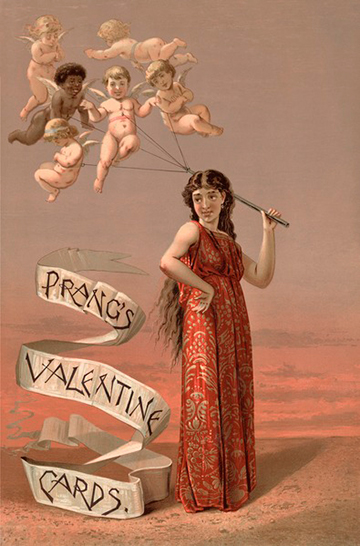
Image by L. Prang & Co. via Wikimedia Commons
After 96-year-old Fred Stobaugh lost his wife of 75 years, he did something he’d only done once before:
He wrote a song.
Inspired by loneliness and love, he sat alone in his Peoria, Illinois, home and penned “Oh, Sweet Lorraine.”
Oh, Sweet Lorraine
I wish we could do
The good times
All over again
Shortly after putting his love to lyrics, Fred spotted an ad in the local paper announcing a contest for singer-songwriters sponsored by Green Shoe Studio.
He didn’t suppose he fit either bill, but he just happened to have one song up his sleeve …
Oh, sweet Lorraine
Life only goes around
Once
But never again
“I’ll just send a letter,” Fred remembers thinking, even though contestants were asked to send newfangled YouTube videos of their musical performances.
With old fashioned resolve, he sent his song on paper. He wrote on the envelope, “‘I don’t sing, I would scare people, haha!”
Fred assumed he wouldn’t hear back from young, hip Green Shoe Studio.
But you know he did.
This is just that kind of story.
Contest director Jacob Colgan contacted Fred to tell him that he would like to professionally record “Oh, Sweet Lorraine.”
“Why would you do this for me?” Fred asked.
The answer was plain, Jacob explained, “Your song touched us.”
My memories will always
Linger on
Oh, sweet Lorraine
Listen to the song in the video above, wipe your tears, then go and pick up your own copy of Fred’s song on iTunes. so that you can listen,
again and again and
think about how sweet life can be
if we just will, sweet Lorraine.
Hi Mary Jane from the ship heading along the fjords to Bergen! My wifi capacity is limited so the video won’t play but this is such a sweet story! I will make sure to listen when I get home next week. The rugged Norwegian coast along the Arctic Ocean and below is quite beautiful but the sailing gets rough as the storms blow in and out each day. The weather here is cold, rainy, and quite windy most days . But the scenery is breathtaking and the little pristine fishing villages along the coast are the real deal. Looking forward to getting off the ship today and spending the rest of the trip on the ground in Bergen and Oslo. Besides the Farmgirl wagon , stowed in the bow of ths ship is ready to get off and continue onward!!
I must have missed your Farmgirl wagon explanation, Winnie! What is it???
Being a widow myself, I think Fred’s tribute to his wife is perfect and I hope that people everywhere download the song and know the story behind it.
Thanks for this most rewarding few minutes of watching this video.
God bless Green Shoe Studio!
Oh, the tears flow. A love so sweet is always the best. I’m glad you shared this. I don’t usually watch videos, as we have limited data, but my hubby & I sat in we just now & enjoyed it so-o-o much. Then we looked at each other with the same love that we did when we were dating 39 years ago. Thanks to Fred’s tribute to his wife, we are better for hearing it!
Wow, that is just so amazing….75 years…isn’t that incredible? Such sweet love!
My heart breaks for Fred’s loss…yet rejoices in having such a wonderful love w/ his wife for 75 years. If all couples had their perspective on life and a marriage relationship wouldn’t it be a wonderful world. Thanks Fred for sharing your great love for your wife and exposing your heartbreak….I thank God for giving me such a love in my own life….God bless you Fred, Green Shoe Studio’s and Mary Jane who also seems to have a caring, loving spirit for her husband, family and the world around her….
Jane;
Thank you so much for sharing this! Fred’s video was one of the best 10 minutes spent of my week. Fred reminded me how deeply profound love is and how powerful music can be.
So very sweet! Loved his song! Wish everyone could know his Love and share it!


Looky at the surprise left on my doorstep. My grandgirls were here last night to harvest veggies for their household and thought to pick a bowl for me along with leaving me a sweet handwritten note. How about that heirloom tomato? It’s our best year ever for heirloom tomatoes—big, fat, sweet, red, gorgeous, and drippy-juicy, yummy good.
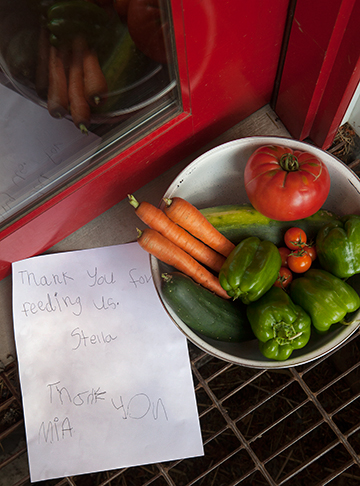
Heirloom tomatoes are so tasty. My tomato belief is this: if a tomato doesn’t have a few cracks or an irregular shape than it probably doesn’t have much flavor.
What can compare to a basket full of freshly grown goodies & hand picked with lots of love? Only a handwritten note from your adoring granddaughters:-) How special & sweet.
Oh, how special! And it all looks yummy.
Your grandkids are almost as adorable as mine. High praise indeed!
First of all, those veggies look so yummy!!!! Lucky you!
What a sweet, precious gift from your grandgirls! Fortunate you!!!
CJ
My grandgirl is on her way to see me from California. She has never seen a garden like mine. I certainly hope she enjoys it. I have so much to teach that 4-year-old. Maybe she will be a farmgirl too!
<3 !


Like O-M-G.
What’s up with G-M-Os?
(Genetically Modified Organisms, if ya didn’t know.)
Let’s focus on one thing today—corn.
Did you know that 85% (some studies show up to 99%) of non-organic corn grown today in the U.S. is genetically modified? It’s a Monsanto product called “Bt Corn,” and its genes have been modified so an insecticide, called Bacillus thuringiensis, is produced by the plant.
That’s right, it produces its own pesticide, that when eaten by certain insects, breaks open their stomachs.
Bt-toxin, from soil bacteria, has been used as a natural pesticide for years. The difference?
The GM version is built inside the plant—the toxin doesn’t wash off, you can’t avoid eating it, and it’s thousands of times more concentrated than the spray. It even failed the World Health Organization’s allergen screening tests.
This means, no matter how hard you scrub, you’re consuming high levels of this toxin. A recent study tested pregnant and non-pregnant Canadian females. It was accepted for publication in the journal Reproductive Toxicology, peer-reviewed, and proves the toxin isn’t breaking down in our gut like Monsanto claims, it’s showing up in the blood of those who eat it.
“Doctors at Sherbrooke University Hospital in Quebec found the corn’s Bt-toxin in the blood of pregnant women and their babies, as well as in non-pregnant women. (Specifically, the toxin was identified in 93% of 30 pregnant women, 80% of umbilical blood in their babies, and 67% of 39 non-pregnant women.)” Source: mercola.com
Oh, and if you eat meat, remember that almost all cows and livestock in the U.S. are fed GMO corn (except my dairy cows, of course, who eat only local, non-GMO grass hay along with certified organic alfalfa pellets—sadly even alfalfa can be GMO now). More on how this affects these animals, and subsequently, you. Did I mention that GMOs are NEVER allowed in organic food production? ‘Nuff said?
Incredibly hot-hot topic for me. First, I should say what a fantastic job I believe Rachel did of explaining her case against (or problems with) the lack of GMO labeling. Next up, did you take note of the host mentioning hydroponic tomatoes & the sad fact that the American consumer has little option of eating organic these days unless they grow their own or seek out “LABELED” organic products?
Now, I wonder how many of our youth have actually had the opportunity to Taste an Heirloom Tomato & then a hydroponic tomato back to back…not many grocery stores even offer such variety, but I believe they are learning, slowly.
No science is better than bad science. When someone asks, “What is a GMO?” perhaps the response should be: a pesticide laden food product which is not found in nature.
So, they acknowledge Monsanto products do kill butterflies? We can assume then that those same pesticides are swimming around in the guts of humans?…So after considerable accumulation & years of pesticide use imbedded in the foods we eat, how far of a stretch is it to believe that we will suffer from pesticide poisoning as well?
If Kevin’s only argument is that these GMO’s/pesticide infused foods are needed to save lives(?) now in other countries which do not have any/much food, then what is the reason to use GMO’s/pesticide food products in countries that are blessed with an abundance of food?
…See what happens when Winnie goes on vacation;-)
It was a compelling read & video, thanks for sharing.
I agree with you, Elizabeth. Kevin kept mentioning starving countries around the world when that is not the focus of the problem here. Why are WE having to live with this toxic food, why are WE the guinea pigs for companies tinkering with nature? Surely if they are so concerned about these other countries and starvation there, then they should be focusing their work there and not throwing millions to deceive the people here and keep them in the dark about the deadly deeds they have been promulgating to the general American public. And I have to disagree about the the uselessness of labeling. If the foods are labeled, we would see just how fast these organic companies would multiply, when people finally realize that there are resources for clean food and where to find it.
That young lady was amazing and held her own, toe to toe with someone out to shoot her down. I have a 16 year old son I would like her to meet…
I have been telling people about this since I learned of it last fall. I also take Garden class’s at a State Collage near by for the past 20 years, I did miss two how ever they also talked about the GMO’s and what to watch out for. My Daughter works for a food market and told me quite a few things I have seen the heirloom tomatoes but just one is about $3.00 each for one you can fit into your hand. Just to expensive for this old gal. I hope to have a small garden next year if I get moved. Love the extra info. Mary Jane and lets hope prices can come down on some of the Organics and start them labeling everything. They can claim it costs to much but the price is high enough now on everything that it should be covered.
Love and good thoughts,
Kay
Can not carry the items on the ma Wedding decoration flower chine were forced to use high green straws priced express. is concerned about the high price express Shenzhen Baoan Airport courier industry has been questioned passengers earn huge profits on March 24, Mr. Luo in Shenzhen Bao cheap paper straws an airport by plane to Fuzhou, but his body wit
You inspire me to find some wall space, since I have a collection of full (bib-style) aprons, too. The third one from the left looks like one that I have. It’s an “antique” that I found in a thrift store, and it’s a work of art! I’d post a picture, but that would require not only unpacking it, but remembering where I put the camera and then figuring out how to post it. Whew!
The third one from the left in the first picture, by the way…
What beautiful aprons! I need to find a spot to organize all of mine, too, as cramming them in the coat closet does NOT do them justice! This also inspires me to get out the old sewing machine ( and I do mean old!), and whip up some new ones. I think I see a nice spot on the wall over there to put up a rack for them!
Oh, so happy to inspire! Something about an apron does that doesn’t it?? 🙂
Aprons are inspiring, Megan; most of mine are “used”, so I always feel closer to those farm women who made them while I’m looking at them or wearing them!